Five main types of solar water heating systems are sold today. These five are a distillation of dozens of types sold over the past 25 years. They are:
The proven winners are simple, reliable, and long lasting. Some systems are "open loop" (the domestic water itself is directly heated) and some are "closed loop" (a heat-transfer fluid is heated by the collector and the heat is passed on to the domestic hot water by means of a heat exchanger). Some systems are "active," using moving parts such as pumps and valves, and others are "passive," using no mechanical or moving parts.
There are many considerations in choosing the best system for a home, but the client and the situation will dictate the right system.
For instance, for a one- to two-person household in a temperate climate where hard freezes rarely occur, you might go with a batch heater, especially if the hot water will be used more at the end of the day rather than first thing in the morning. In a household with three or more people, where aesthetics and weight are not an issue, the thermosyphon system might fit the bill, especially if there´s no room for an additional tank near the existing water heater.
The drainback system, a personal favorite here in the Northwest, requires continuous drop between the solar collector and the solar storage tank. If continuous fall is not possible, there´s always the pressurized glycol system where piping can go up, down, over, and around without concern. Usually more than one option can work for any situation.
The number of people in the household will dictate how large the system will need to be, and which systems are even possible. Rebate and incentive programs may only qualify certain systems in a given area. Some systems are relatively easy to install for do-it-yourselfers, while others most laypeople shouldn´t attempt. See the comparative chart showing features of the different system types. Make your choice, and enjoy using solar energy to heat your water!

Solar Batch Heaters
For a hundred years, simple solar batch heaters have been used in the
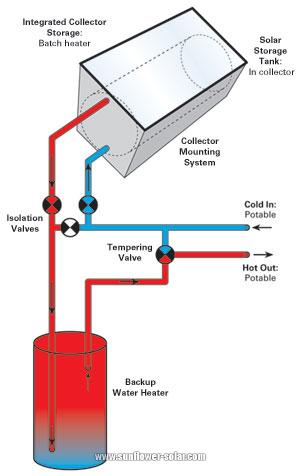
Unit ed States. The term ICS (integrated collector storage) tells us that the collector and storage tank are combined into one unit. A tank of water, enclosed in an insulated box covered with glass, is placed in the sun facing south. Cold water is piped to the bottom of the tank; hot water is taken off the top. Whenever there´s a call for hot water, water pressure from the home moves hot water from the top of the solar batch heater as cold water is pushed into the bottom.
Since the potable water is heated directly, this is an open-loop system. And since no pump is used to move the water from collector to end use, it is passive. The batch heater is a popular choice for homes in moderate climates where freezing is not much of an issue. Commercially manufactured batch heaters are relatively low cost. Crude batch heaters can even be homemade. If batch heaters are installed on the roof, weight has to be taken into account. Commercial batch heaters can weigh 200 pounds (90 kg) dry, and when filled with 40 gallons (150 l) of water, more than 320 pounds (145 kg) is added.
Because of their relatively low cost and simplicity, for those living in moderate climates with good sunshine available, the batch heater is probably the best value for heating domestic water.
The following illustration includes the primary components of any solar batch heater system. See our
Solar Hot Water System Components section for an introduction to the function(s) of each component.
Thermosyphon Systems
Another relatively simple, passive system, and the most popular solar water heater worldwide is the thermosyphon. Common in Japan, Australia, India, and Israel, they are easily recognizable because the tank must be located directly above the collector.
Thermosyphon systems work on the principal of heat rising. In an open-loop system (for nonfreezing climates only), potable water enters the bottom of the collector and rises to the tank as it warms. In colder climates, an antifreeze solution, such as propylene glycol, is used in the closed solar loop, and freeze-tolerant piping, such as cross-linked polyethylene (PEX), is used for the potable water lines in the attic and on the roof.
Several international manufacturers make thermosyphon systems. The advantage of this system over the batch heater is that solar heat is stored in a well-insulated tank, so hot water can be used any time, without the penalty of overnight losses.
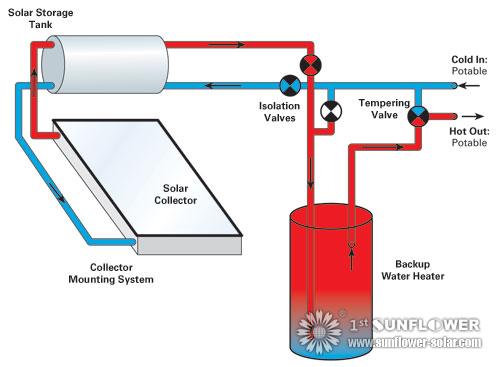
Open-Loop Direct Systems
Used in tropical settings where freezing never occurs, this is the simplest of the active systems. A standard, 52-gallon (200 l) electric tank can be used, teamed with a 40-square-foot (3.7 m2) solar thermal collector. Normally the electric element is not hooked up, so this tank becomes a storage tank only, for preheated water feeding an existing backup water heater.
An air vent, automatic or manual, is installed at the high point of the solar thermal collector to initially purge air. The pump, a small circulator pump using as little as 10 watts, can be powered directly by a 10-watt PV module, or a thermostatically controlled AC pump can be used. A snap-switch sensor can be installed to limit the temperature the solar tank reaches. Standard snap-switch sensors are available for 160°F or 180°F (71 or 82°C).
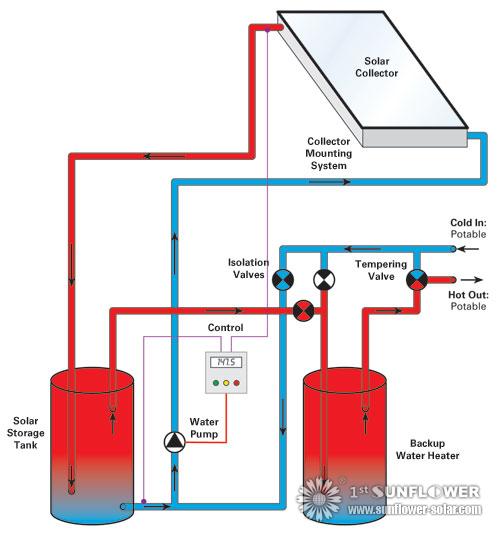
Pressurized Glycol Systems
In this active, closed-loop system, incoming potable water is routed to the solar storage tank, but never into the collectors. A water and antifreeze mixture circulates from the collectors through a coil of pipe in the solar tank, and then is pumped back through the collectors. (In most climates, a 50/50 propylene glycol and water mixture will keep collectors from freezing.) The potable water is warmed by heat transfer through contact with the pipe.
These systems require an expansion tank and a few other auxiliary components for filling, venting, and maintaining the system. A definite advantage to antifreeze systems is that the collectors can be mounted anywhere. These systems are pretty much the only choice in very cold climates.
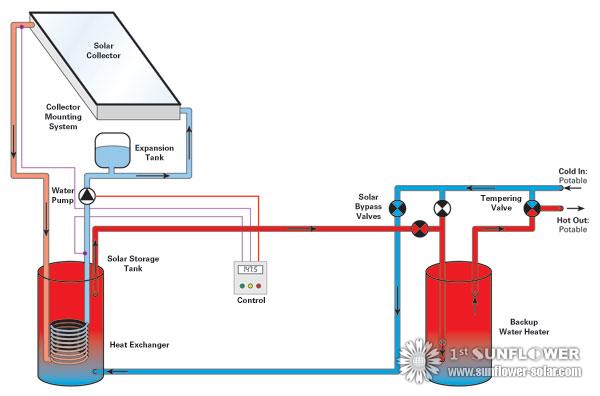
Closed-Loop Drainback Systems
The closed-loop drainback system requires perhaps the least routine service of any active system. The heat-transfer fluid is distilled water, which seldom has to be changed. When the system is at rest (not pumping), the solar collector is empty and the distilled water is stored in a 10-gallon (38 l) reservoir tank, usually located just above the solar storage tank. Higher capacity reservoir tanks are typically required in large systems.
When the pump turns on, the distilled water is circulated from the reservoir back through the collector and heat exchanger, passing heat to the potable water in the solar tank. When the pump shuts off again, the distilled water drains back into the reservoir. The collector must therefore always be higher than the storage tank, and there must be sufficient continuous slope in the piping to ensure against freezing.
Drainback systems are effective and reliable. They work great, even on the hottest and coldest days of the year, and can operate twenty years without needing service. The only downside is that larger pumps usually have to be used, especially if you´re pumping water two stories or more, since the drainback pump has to lift the distilled water to the height of the solar collectors.
One way around the height problem is to place the reservoir in the attic, reducing the height the pump has to lift. However, if it´s located in a place where the pipes going to and from the reservoir could freeze, glycol must be added. This is also done when long, horizontal pipe runs do not allow drainback to occur quickly.
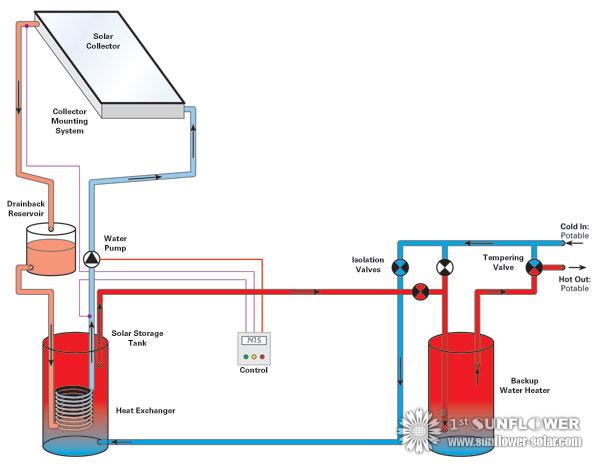
^Back to top